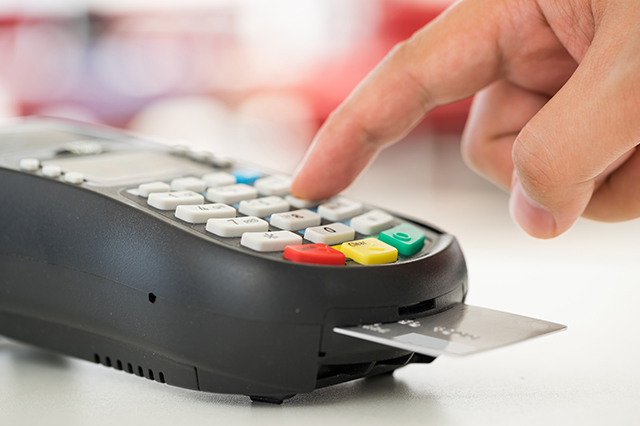As you probably know, virtually all credit cards in the United States are now equipped with EMV chips. EMV is short for “Europay, MasterCard and Visa,” the three companies who began the chip technology initiative. There are two main types of chip technology in credit cards – chip and signature and chip and PIN.
The technology has quickly become the gold standard for all credit card transactions. Here’s how it works – A small microprocessor is embedded in your credit card to store and protect your sensitive data. This information is used for all transactions, replacing the magnetic strip on the back of your credit card. The information embedded within the chip is encrypted, and therefore less vulnerable to counterfeiting and fraud.
Chip technology in credit cards has been around for a few years now, but merchants and consumers are still adjusting to the change. Here’s what you need to know about your EMV chip card.
Why is a credit card chip more secure?
EMV chip cards support dynamic authentication, which makes it much harder to copy and counterfeit. Data stored on traditional magnetic strips are static, making them much easier to skim with a card reading device. Dynamic information stored within your credit card chip must be verified by the point-of-sale device, ensuring its authenticity. Chip credit cards also generate a unique authentication code with each transaction.
In the United States, most cards use chip-and-signature technology – the secure chip in your card, combined with a signature for verification. For the added security of a signature, merchants must verify the signature on the card with the card holder’s on-site signature. This process can be subjective, based on the verification process. In many countries the EMV chip technology is used in combination with a PIN number. Because the chip-and-PIN system uses two types of objective verification, it is widely regarded as more secure than the chip-and-signature technology.
How is the EMV chip card used to make a purchase?
Instead of swiping your credit card through a card reader, the chip system requires you to insert your card into the reader, chip end first, and leave it there until your transaction is complete. For now, credit cards still have a magnetic strip on the back that can be used if the chip technology fails, but those strips will likely be phased out in the future.

Why do chip cards take longer to process?
Consumers who are used to the simple swipe they’ve used in the past may be wondering why the chip system takes so much longer. While you’re tapping your fingers on the counter waiting patiently for your transaction to complete, the microchip in your credit card is having an encrypted conversation with the card reader. The card reader then sends an encrypted message to the bank, which approves the transaction, and sends an encrypted message back.
The whole point of the new chip technology is the added security features, and it’s these features that slow down the process.
Are there security risks with chip credit cards?
While chip credit cards are far more secure than cards with magnetic strips, there are still risks you should be aware of. Because many chip cards still contain the magnetic strip on the back, the cards are still vulnerable to fraud. To prevent skimming, credit card issuers will have to totally eliminate the card’s magnetic strip.
The biggest risk for fraud and theft in the credit card industry today is through the internet. Card-Not-Present or CNP transactions continue to rise as the online shopping market grows. Credit card account information can be gleaned through a breach in a merchant’s online security, as well as phishing scams, or when the physical card is stolen. Because there isn’t a secure card reader available for online sales, internet fraud will become the easiest way for thieves to get ahold of sensitive information.
There is also an increase in application fraud – when a criminal uses your personal information to apply for a new credit card or take over existing accounts. Instead of counterfeiting the physical card, criminals are bypassing the card altogether. Once the account is created, it’s easy to have a new EMV card mailed to them.
The future of credit card security
In addition to EMV chip technology, Visa and MasterCard have implemented extra security protocols that send users an authentication code through their cell phone before they can make a CNP transaction online.
Many credit card companies have been testing and using biometrics as part of their security protocol for credit card use. Facial-recognition software, fingerprint scans, and voice authentication have all been tested for viability within the industry, but have not been implemented on a wide scale.
Because credit card fraud costs companies billions of dollars each year, new technologies are constantly being developed and tested to make transactions more secure for consumers, merchants and banks. Chip technology is our biggest leap forward in many years, but there’s certainly more changes to come.
Have EMV chip credit cards changed the way you make purchases? Are you satisfied with the new system? Let us know in the comments section below.
2 Thoughts on “What You Need to Know About Chip Technology in Credit Cards”
Leave A Comment
Comments are subject to moderation and may or may not be published at the editor’s discretion. Only comments that are relevant to the article and add value to the Your AAA community will be considered. Comments may be edited for clarity and length.


















I NEVER have the cashier ask to see my card to verify my signature… highly disturbing….
I find that fewer retailers are asking to see cards and proof of signatures. It’s somewhat disturbing because anyone can take my card, use it and sign a name.